Tafl Games
Written by Howard Fosdick © BestFreeNewGames.com
Games of unequal strength, in which the two players have different numbers of playing pieces, are sometimes referred to as Tafl games. There are a large number of such games having their origins back in the days of the Vikings and Germanic tribes in northern and central Europe. They found their greatest popularity during the Viking era and the middle ages. Chess largely supplanted these games by the 12th century.
Then, with the rise of the modern nation states of northern Europe in the 19th and 20th centuries, tafl games underwent a renaissance. Archaeologists discovered long-buried boards, public interest spiked, and the games became a part of the history and culture of northern Europe. Today tafl games are proudly played as part of Scandinavian, Germanic, Irish, Celtic, and British cultures. And many others learn of these fun games through internet gaming sites like this one. Quite apart from historical importance, these games are simply great entertainment.
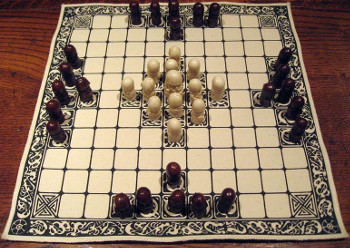
What's a Tafl Game?
Tafl games are played on checkers-like boards of varying sizes. Typically, one player directs a small army defending a King's throne or a fortress in the center of the board. Surrounding them is a much larger army directed by the opponent, initially placed around the edges of the board.
The defender's goal is either to eliminate the attackers or move the King to one of the safe "escape" squares at the board's edge. The attacker's objective is to capture the King.
All pieces move orthogonally, that is, vertically or horizontally (but not diagonally). Each player moves one piece per turn, and a piece may move any number of spaces (like the Rook in chess). Capture is custodial. That is, one captures an enemy piece by positioning a piece to each side of the captured soldier. (See our description of the Irish tafl games Brandubh and Fitchneal for complete game rules with examples.)
The size of tafl game boards, numbers of pieces, and precise rules vary. Generally, the attacker has an advantage of about 2:1 in playing pieces.
Known Tafl Games
Modern tafl is based in large part on archaeological finds. Certain sagas, poems, and other writings provide fragmentary information on rules. Perhaps the only complete set of surviving game rules were recorded by Carl Linnaeus during his expedition to Lapland in 1732.
Thus, you will find slightly different versions of the rules for these games all over the internet. We derived our own by researching dozens of such websites, combining and comparing them, and also accessing "official" rules of modern organisations such as those of the World Tafl Federation. In the end, most of the modern world agrees on a fairly common set of tafl game rules.
Here are some of the main tafl variants known and played today:

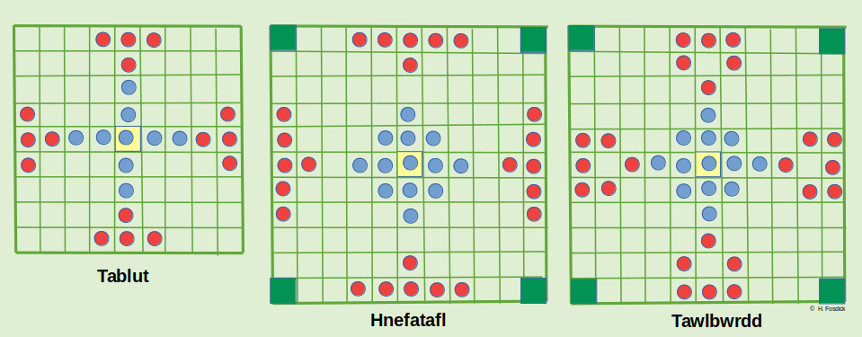
Our Games
We present three tafl games on this website:
All can be played on the same 7 by 7 board. We supply several free game boards that you can print here.Join an historic tradition. But more importantly, have fun with these great games!
Beautiful Boards
Part of the fun of tafl is obtaining your favourite board. Beyond the boards we supply for free download, if you get serious about tafl, you'll probably want to buy -- or make -- your own. Here are some handsome boards we've seen on Etsy, Pinterest, or similar websites:


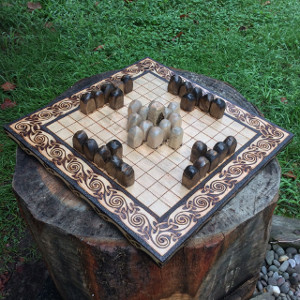

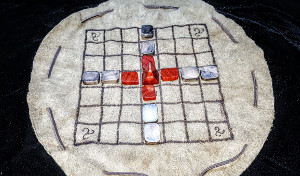


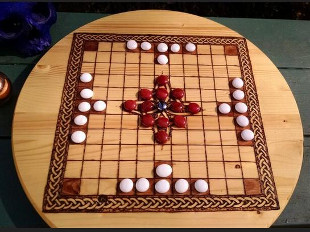

-----------------------------------
Sources:
Originally sourced from R.C. Bell, Discovering Old Board Games. For another take on tafl, read this Wikipedia article or visit the World Tafl Federation.
If you like board games, see our pages on Teeko, Camelot/Cam/Camette, Ringo, the Jungle Game, and of course, Brandubh and Fitchneal.
-----------------------------------License: Copyright © 2023 by H. Fosdick. HOME